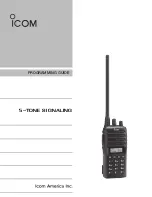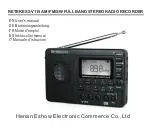
T X 6 1 5 0 / T X 6 8 5
I N S T R U C T I O N M A N UA L
PA G E 9
GENERAl OpERATION
Power on/off
Rotate the
voluMe
control clockwise past the ‘click’ to turn the radio on. The radio will emit a
confirmation tone when it is switched on. Rotate the
voluMe
control counter-clockwise past the
click to turn the radio off again.
Adjusting the volume
With the unit powered on, rotate the
voluMe
control clockwise to increase the volume and
counter-clockwise to decrease the volume.
Display lighting
The LCD backlighting activates automatically whenever a key is pressed and turns off automatically
after about 5 seconds.
Receiving signals
While the radio is not receiving signals, it will remain in standby mode to conserve battery power.
When a signal is received, the LED indicator on the upper edge of the radio will light GREEN and the
icon will appear on the display. Adjust the
voluMe
control for a comfortable listening level.
If the incoming signal is encoded with a CTCSS or DCS tone matching the one set in your radio, the
LED indicator will light ORANGE and you will be able to hear the signal in the speaker. If the LED
indicator lights GREEN and the
icon appears but you cannot hear the signal, it is likely that
the incoming signal is using a different CTCSS or DCS tone to that selected in your radio (see Menu
options for more details on setting CTCSS/DCS tones).
If no further signals are received, the unit will return to standby mode.
Transmitting
To transmit, press and hold the
PTT (Push-To-Talk)
switch. The other radio you are talking to
must be set to the same channel. Hold the radio approximately 5 to 8 cm from your mouth with the
antenna vertical and speak into the built-in microphone.
While the
PTT
switch is pressed, the LED indicator on the upper edge of the radio will light RED and
the
icon will appear on the LCD. When you have finished speaking, release the
PTT
switch to
receive incoming signals (it is not possible to transmit and receive at the same time). If no further
signals are received, the unit will revert to standby mode.
TiP:
The
PTT
switch can also be used to transmit a Call Alarm melody. When the Call Alarm
melody is enabled (see Menu options for more details on Call Alarm settings), pressing the
PTT
switch twice quickly will play the Call Alarm melody in the speaker of other radios on the
same channel to alert them to your call. During this time the
icon is displayed and the LED
indicator will light RED for about 5 seconds. The Call Alarm can only be sent once per minute.
selecting Channels
In the ‘standby’ mode, press the key to step up one channel or the key to step down one
channel. Press and hold the or keys to quickly scroll through the channels.
squelch
The squelch is used to eliminate the background noise when there are no signals present. When
the squelch is open the receiver’s background noise can be heard. When the squelch is closed the
receiver remains quiet while there are no signals present but any incoming signals will override the
squelch and be heard in the speaker.
To open the squelch, briefly press the
sQl
key. This will allow you to check the current channel
for activity before transmitting, particularly if you have CTCSS enabled. When the squelch is open,
the LED indicator on the upper edge of the radio will light GREEN and the and
icons will
appear on the display. During this time you will hear static or hiss if the channel is clear. Do not
transmit if you hear any signals.
To close the squelch, briefly press the
sQl
key again.






































